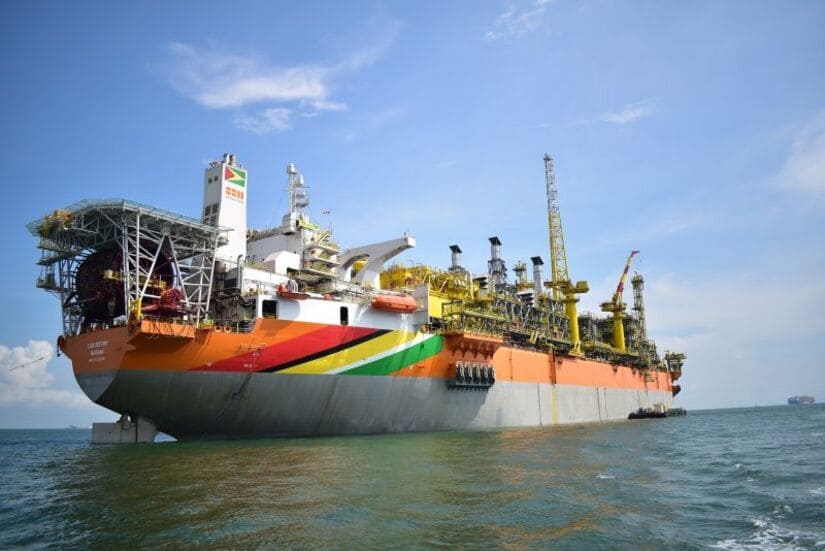US ExxonMobil continues to focus on boosting oil production in Guyana; The company is preparing to approve its fifth project, which is scheduled to start production in 2027 for a period of 20 years, according to estimates by the Government of Guyana.
ExxonMobil’s proposed fifth development at the Oro oil field would pump about 250,000 barrels of oil per day at its peak, according to Reuters.
These efforts will be in large addition to the $30 billion pledged so far by the US company Hess and China’s Sinooc, the US company’s partners, and Guyana.
It will be the largest and most expensive project implemented by the consortium, surpassing the $10 billion cost of the fourth project, according to information monitored by the specialized energy platform.
ExxonMobil in Guyana
ExxonMobil’s head of Guyana operations, Alistair Routledge, said the company had submitted a development plan for the oilfield and an initial construction contract was awarded last fall to Japan’s Modec.
If the Government of Guyana approves the Plan; The consortium could agree to spend on the project around April, when Guyana is scheduled to hold its first competitive auction for new exploration blocks.
The head of state said ExxonMobil would consider bids for the new blocks, to which Routledge commented, “Of course, we’ll look into it,” adding that it would be “too early to say yes or no” to participation before the state issues the full terms of the new production contracts.
The cost of the project may increase, Alistair Routledge said, referring to energy industry inflation that has driven up prices for services and materials.
The development will cost about $12.68 billion, according to an estimate by Guyana’s Environmental Protection Agency, up 27 percent from ExxonMobil’s fourth development.
Guyana estimated last week that the project would require up to 600 workers at peak drilling activity, and employ up to 160 people thereafter. It is expected that the project will release about one million tons of carbon dioxide emissions annually.
Guyana oil reserves
The alliance aims to pump 1.2 million barrels of oil and gas per day by 2027 from all developments, according to Hess, which is nearly 3 times last year’s production (2022).
Guyana has emerged as the world’s fastest-growing oil region, since ExxonMobil made its first offshore discovery in 2015.
The coalition has found about 11 billion barrels of oil and gas, and Guyana estimates its fields could contain 25 billion barrels, and aims to produce 1.64 million barrels per day by the end of the decade.
Guyana is working to increase its oil production to 1.64 million barrels per day by 2030; This prompted it to search for foreign investments to boost the hydrocarbon sector.
And the country revealed – last year – a financial system that raises Guyana’s share of oil wealth to 27.5%, from 14.5%, through a mixture of revenues and co-production; But it has not yet updated the production sharing agreement for the boxes.
The following chart – prepared by the specialized energy platform – shows the developments of oil production in Guyana:
New oil licences
ExxonMobil and its partners opened production in Guyana in 2019, and today it delivers all of the country’s oil production, from the 6.6-million-acre (26.8,000-square-kilometer) Starbrook block.
ExxonMobil is the operator of the Stabroek Square with a 45% stake, Hess 30%, and China’s Sinooc Corporation owns the remaining 25% stake.
The offered areas are likely to double the marine area being explored by the ExxonMobil consortium.
The licenses will cost about $10 million for 11 shallow water blocks and $20 million for 3 very deep water blocks; The 14 blocks cover about two thousand square kilometers each.
The government wants the auction to reduce its dependence on ExxonMobil and its partners, who have become the backbone in the shift from an agricultural-based economy to an industrial one.
Guyana’s efforts to increase production
In this context, the President of Guyana, Muhammad Irfan Ali, seeks the participation of Indian public and private companies and skilled manpower in his country’s development efforts, particularly in the oil and gas sector.
Irfan Ali and President of Suriname Chan Santokhi – during their visit to India – held talks, on Monday, January 9, with Indian Prime Minister Narendra Modi, at a conference in the state of Madhya Pradesh in central India.
India’s Ministry of External Affairs Secretary Saurabh Kumar said Guyana is home to one of the largest oil discoveries of the past decade and is currently producing 340,000 barrels per day of oil, according to Reuters.
Kumar explained that the “main message” delivered by Ali in his meeting with Modi was that Guyana wanted India’s public and private sector entities to participate in development as the country prepared for further growth on the back of oil and gas discoveries.
related topics..
Also read..

Leave a Reply